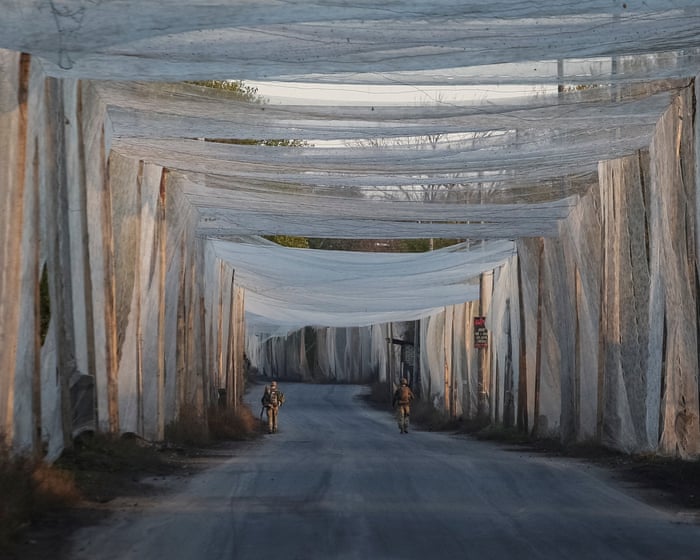Along the fishing ports of Brittany’s coast in France, discarded fishing nets are piling up on the quaysides. These deep-sea nets typically last between one and two years before they wear out and can no longer be repaired. For years, the roughly 800 tonnes of nets thrown away annually have posed a disposal challenge.
Now, however, these horsehair nets—once used to trawl for monkfish on the ocean floor—are being repurposed to catch a different target: Russian drones. The Breton charity Kernic Solidarités has already sent two shipments totaling 280 kilometers of nets to Ukraine, where they are used to shield soldiers and civilians in the most intense combat zones.
Russia deploys small, inexpensive drones equipped with explosives, guiding them remotely for distances up to 25 kilometers. Ukrainians stretch the nets to form tunnels where the drones’ propellers get tangled—much like a spider trapping flies in its web.
“The war has changed over the past two years. Before, we hardly thought about drones, but now it’s a drone war,” said Christian Abaziou, 70, who handles logistics for Kernic Solidarités. “The Ukrainians told us they don’t want just any old nets—they’ve received many that are useless. The nets we send are made of horsehair and were used for deep-sea monkfish fishing. Monkfish are strong and hit the nets with force similar to a drone.”
Fishing nets have also been sent to Ukraine from France, Sweden, and Denmark.
“At first, doctors used them to protect medical camps near the front line,” Abaziou added. “Now they’re being used on roads, bridges, and hospital entrances. It’s amazing how well such a simple solution works.”
Gérard Le Duff, president of Kernic Solidarités and grandson of a Breton fisherman, said, “The Ukrainian ambassador visited Brittany and thanked us for our efforts. We have no shortage of fishing nets in this region—in fact, it’s a problem knowing what to do with them, especially since some recycling companies have closed. If they can use them to build anti-drone barriers and save lives in Ukraine, they’re welcome to them.”
Kernic Solidarités was founded after local Ukrainians approached Le Duff and Abaziou seeking help with clothing, food, and medical supplies for their homeland. The charity’s 20 volunteers have driven two truckloads of aid 2,300 kilometers to the Ukrainian-Polish border.
“When we learned Ukraine needed nets, the fishing community responded quickly,” Le Duff said.
Russia uses first-person-view drones, similar to commercial models, which are packed with explosives and guided by pilots using real-time video feeds. Ukrainian forces report that in some areas, nothing can move without drawing swarms of these “killer” kamikaze drones.
The fishing nets are stretched between poles to create tunnel-like barriers or draped over trenches and vehicles. Ukrainian drones are also fitted with net fragments to drop onto enemy drones.
By July of this year, Ukraine was facing more than 500 drones per day.
Fishermen in Sweden and Denmark have also donated hundreds of tonnes of old nets.
Jean-Jacques Tanguy, former president of the Finistère fisheries committee, confirmed the initiative’s broad support.Local fishers are eager to support the war effort, expressing pride that their old gear is being used to save lives, according to an AFP report.
Abaziou mentioned that the association lacks the funds to ship more supplies this year and is in talks for Ukraine to arrange trucks to collect the nets. “We’ll assist in gathering and loading the nets, but we can’t afford to keep organizing convoys ourselves,” he explained.
Iryna Rybakova, a spokesperson for Ukraine’s 93rd Mechanised Brigade, informed Radio Free Europe that anti-drone net tunnels are being set up throughout the Donetsk region, which is now about 75% under Russian occupation. She noted that enemy drone operators are increasingly finding ways to get through the nets. “Nets aren’t a cure-all; they’re just one part of the defense against drones,” she stated.
Abaziou, a retired market gardener, shared that Ukrainians he encountered were touched by the solidarity from Brittany’s coastal communities. “Knowing that fishing communities across Europe are sending nets to help protect them has moved some to tears,” he said.
Frequently Asked Questions
Of course Here is a list of FAQs about the use of discarded French fishing nets as defenses against drones in Ukraine designed to be clear and conversational
General Beginner Questions
1 Whats the basic idea here
Old fishing nets from France are being collected processed and sent to Ukraine to be used as camouflage and physical barriers to stop or disrupt enemy drones
2 How can a fishing net stop a military drone
The nets are hung over valuable equipment vehicles or positions When a drone flies into one its rotors get tangled causing it to crash or become useless before it can reach its target
3 Why use old fishing nets specifically
They are strong flexible and often made of durable synthetic materials like nylon that are hard for drones to break through Using discarded nets also solves an environmental problem by recycling waste
4 Who came up with this idea
This is often a grassroots effort typically started by volunteers NGOs or Ukrainian groups who identified a need for lowcost effective defenses and found a creative solution using available materials
5 Is this an official military strategy
While it may not be a primary official strategy its a widely adopted and effective tactic used by military and civilian defense units on the ground Its a form of MacGyvered or improvised defense
Benefits Advantages
6 What are the main benefits of using fishing nets
They are lowcost readily available lightweight for transport and surprisingly effective against lowflying drones Its a brilliant example of recycling and ingenuity
7 Does this help the environment too
Yes Ghost netsdiscarded fishing gearare a major source of ocean pollution harming marine life By collecting and repurposing them this initiative helps clean up coastal ecosystems
Common Problems Limitations
8 Are there any downsides to this method
The nets are mainly effective against smaller slower drones They offer no protection against artillery missiles or larger more advanced military drones
9 Couldnt a drone just see the net and avoid it
Often these nets are used as camouflage nets draped to break up the outline of a vehicle or position They are hard to spot especially for a fastmoving drone




